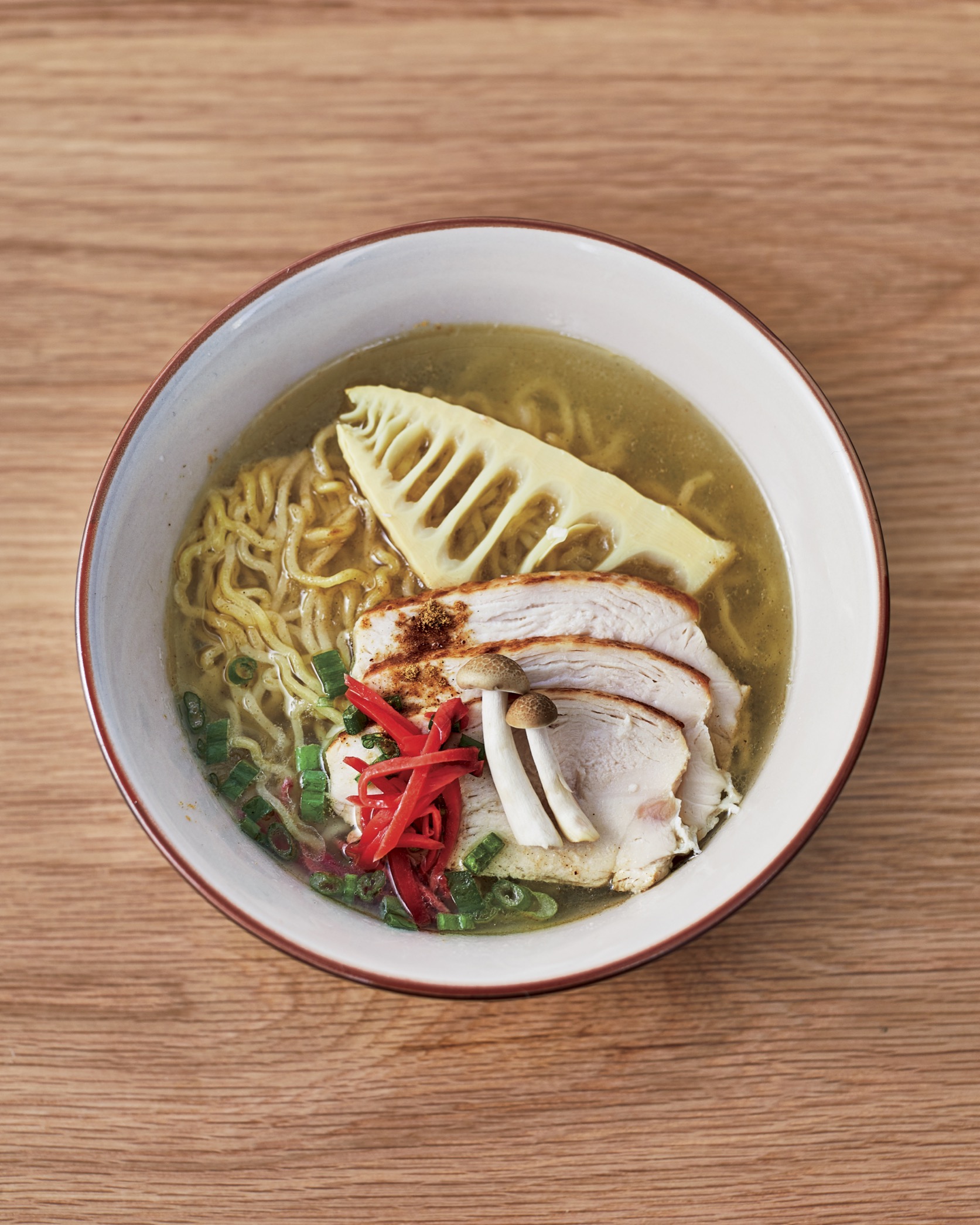
SHIO RAMEN
// MAKES 4 BOWLS
Shio (salt) ramen is the Japanese version of Grandma’s chicken soup. It’s deceptively simple, but when it’s done right, it’s the most soothing soup there is. Most shops use pork in the broth and the toppings, but I prefer to keep this recipe all chicken. You can vary the recipe by subbing pork fat, pork chashu, etc.
This ramen is what we call a double soup, as it has chintan broth and dashi mixed together, and it’s a prime example of simple yet powerful umami.
Note
This recipe assumes that you have broth, tare, and fats already made. From there, plan to make all the toppings before assembling bowls. (For more on ramen assembly instructions, see this page.)
EQUIPMENT NEEDED
Large pot for blanching greens
Large bowl for ice bath
Large stockpot with strainer or double boiler with holes
Large pot for broth
FOR TOPPINGS:
1 Koji Chicken Breast, sliced or shredded
2 cups greens, such as whole-leaf spinach, bok choy, mustard greens, or turnip greens
4 tablespoons thinly sliced scallions (green parts only)
FOR RAMEN:
8 tablespoons Shio Tare (best made at least 1 day in advance)
4 tablespoons Ginger Chicken Fat
4 pinches fish powder (ground katsuobushi)
4 pinches ground white pepper
4 cups chintan broth
2 cups dashi broth, combined with chintan broth (must be made 2 days in advance)
18 ounces fresh ramen noodles, or 12 ounces dried
-
Bring the chicken to room temperature.
-
Blanch the greens: In a large pot, bring 4 quarts of water to a boil. Prepare an ice bath in a large bowl.
-
The idea is to poach the whole leaf, stem included, for presentation and texture. When the water is boiling, add the greens and cook for about 30 seconds. Immediately plunge the greens into the ice water, pat them dry, and lay the leaves vertically next to one another on a cutting board. Cut the leaves into 2-inch strips and set aside.
ASSEMBLY:
-
Fill your biggest pot three-quarters full with water over high heat to bring the water to a boil, ideally with a strainer (or double boiler with holes) that fits into it.
-
Meanwhile, make sure your serving bowls and all toppings, tare, and fats are laid out for easy access.
-
Place 2 tablespoons of the tare, 1 tablespoon of the chicken fat, 1 pinch of the fish powder, and 1 pinch of the pepper into each individual serving bowl.
-
In a separate large pot affixed with a temperature gauge over medium heat, combine the chintan and the dashi and heat the broth to 190°F (do not boil).
-
Slice the ramen eggs in half and set aside.
-
Cook the noodles according to the package instructions, minus a few seconds of cooking time, as the noodles will continue to cook in the hot broth.
-
When the noodles have about 30 seconds of cooking time left, ladle 1½ cups of broth into each bowl. When the noodles are done, pull the strainer containing them out of the hot water, and using chopsticks, divide the noodles as evenly as possible among the serving bowls, working as quickly as you can.
-
Once the noodles are in, use chopsticks to lightly stir them around, so that the broth and fat evenly coat each noodle. Then grab as many noodles as possible, pull them upward out of the broth, and lay them flat across the top, creating a sort of raft on which to lay the toppings.
-
To each bowl, add 1 cup of the shredded chicken, ¼ cup of the blanched greens, 1 tablespoon of the scallions, and half an egg. Serve immediately.
